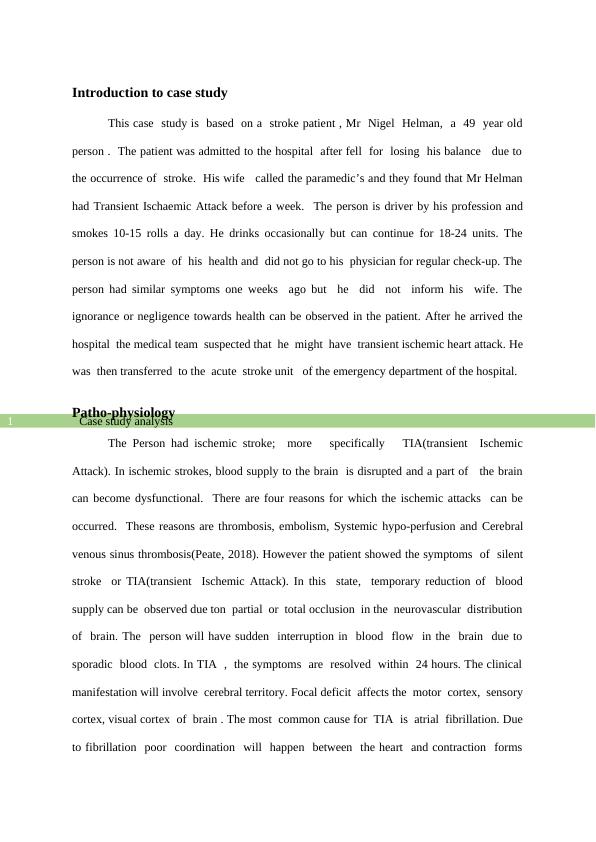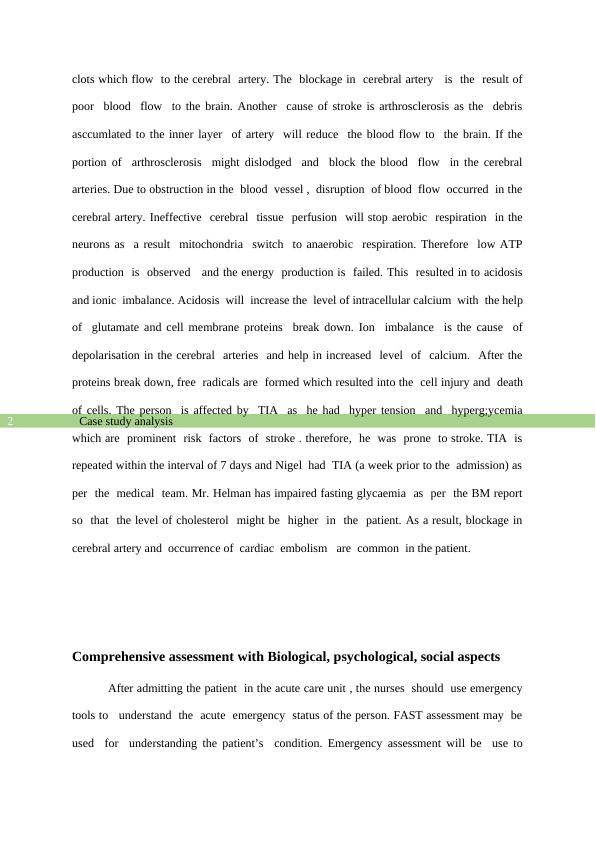Case Study Analysis of Stroke Patient
The assignment involves analyzing the stroke patient journey of Mr. Nigel Helman and exploring the role of nurses in assessing health risks and providing appropriate care for common health concerns.
12 Pages3093 Words58 Views
Added on 2022-08-25
Case Study Analysis of Stroke Patient
The assignment involves analyzing the stroke patient journey of Mr. Nigel Helman and exploring the role of nurses in assessing health risks and providing appropriate care for common health concerns.
Added on 2022-08-25
ShareRelated Documents
Running Head : Nursing
Case study Analysis
Name of the Student
Name of the University
Authors Note
Case study Analysis
Name of the Student
Name of the University
Authors Note

Case study analysis1
Introduction to case study
This case study is based on a stroke patient , Mr Nigel Helman, a 49 year old
person . The patient was admitted to the hospital after fell for losing his balance due to
the occurrence of stroke. His wife called the paramedic’s and they found that Mr Helman
had Transient Ischaemic Attack before a week. The person is driver by his profession and
smokes 10-15 rolls a day. He drinks occasionally but can continue for 18-24 units. The
person is not aware of his health and did not go to his physician for regular check-up. The
person had similar symptoms one weeks ago but he did not inform his wife. The
ignorance or negligence towards health can be observed in the patient. After he arrived the
hospital the medical team suspected that he might have transient ischemic heart attack. He
was then transferred to the acute stroke unit of the emergency department of the hospital.
Patho-physiology
The Person had ischemic stroke; more specifically TIA(transient Ischemic
Attack). In ischemic strokes, blood supply to the brain is disrupted and a part of the brain
can become dysfunctional. There are four reasons for which the ischemic attacks can be
occurred. These reasons are thrombosis, embolism, Systemic hypo-perfusion and Cerebral
venous sinus thrombosis(Peate, 2018). However the patient showed the symptoms of silent
stroke or TIA(transient Ischemic Attack). In this state, temporary reduction of blood
supply can be observed due ton partial or total occlusion in the neurovascular distribution
of brain. The person will have sudden interruption in blood flow in the brain due to
sporadic blood clots. In TIA , the symptoms are resolved within 24 hours. The clinical
manifestation will involve cerebral territory. Focal deficit affects the motor cortex, sensory
cortex, visual cortex of brain . The most common cause for TIA is atrial fibrillation. Due
to fibrillation poor coordination will happen between the heart and contraction forms
Introduction to case study
This case study is based on a stroke patient , Mr Nigel Helman, a 49 year old
person . The patient was admitted to the hospital after fell for losing his balance due to
the occurrence of stroke. His wife called the paramedic’s and they found that Mr Helman
had Transient Ischaemic Attack before a week. The person is driver by his profession and
smokes 10-15 rolls a day. He drinks occasionally but can continue for 18-24 units. The
person is not aware of his health and did not go to his physician for regular check-up. The
person had similar symptoms one weeks ago but he did not inform his wife. The
ignorance or negligence towards health can be observed in the patient. After he arrived the
hospital the medical team suspected that he might have transient ischemic heart attack. He
was then transferred to the acute stroke unit of the emergency department of the hospital.
Patho-physiology
The Person had ischemic stroke; more specifically TIA(transient Ischemic
Attack). In ischemic strokes, blood supply to the brain is disrupted and a part of the brain
can become dysfunctional. There are four reasons for which the ischemic attacks can be
occurred. These reasons are thrombosis, embolism, Systemic hypo-perfusion and Cerebral
venous sinus thrombosis(Peate, 2018). However the patient showed the symptoms of silent
stroke or TIA(transient Ischemic Attack). In this state, temporary reduction of blood
supply can be observed due ton partial or total occlusion in the neurovascular distribution
of brain. The person will have sudden interruption in blood flow in the brain due to
sporadic blood clots. In TIA , the symptoms are resolved within 24 hours. The clinical
manifestation will involve cerebral territory. Focal deficit affects the motor cortex, sensory
cortex, visual cortex of brain . The most common cause for TIA is atrial fibrillation. Due
to fibrillation poor coordination will happen between the heart and contraction forms

Case study analysis2
clots which flow to the cerebral artery. The blockage in cerebral artery is the result of
poor blood flow to the brain. Another cause of stroke is arthrosclerosis as the debris
asccumlated to the inner layer of artery will reduce the blood flow to the brain. If the
portion of arthrosclerosis might dislodged and block the blood flow in the cerebral
arteries. Due to obstruction in the blood vessel , disruption of blood flow occurred in the
cerebral artery. Ineffective cerebral tissue perfusion will stop aerobic respiration in the
neurons as a result mitochondria switch to anaerobic respiration. Therefore low ATP
production is observed and the energy production is failed. This resulted in to acidosis
and ionic imbalance. Acidosis will increase the level of intracellular calcium with the help
of glutamate and cell membrane proteins break down. Ion imbalance is the cause of
depolarisation in the cerebral arteries and help in increased level of calcium. After the
proteins break down, free radicals are formed which resulted into the cell injury and death
of cells. The person is affected by TIA as he had hyper tension and hyperg;ycemia
which are prominent risk factors of stroke . therefore, he was prone to stroke. TIA is
repeated within the interval of 7 days and Nigel had TIA (a week prior to the admission) as
per the medical team. Mr. Helman has impaired fasting glycaemia as per the BM report
so that the level of cholesterol might be higher in the patient. As a result, blockage in
cerebral artery and occurrence of cardiac embolism are common in the patient.
Comprehensive assessment with Biological, psychological, social aspects
After admitting the patient in the acute care unit , the nurses should use emergency
tools to understand the acute emergency status of the person. FAST assessment may be
used for understanding the patient’s condition. Emergency assessment will be use to
clots which flow to the cerebral artery. The blockage in cerebral artery is the result of
poor blood flow to the brain. Another cause of stroke is arthrosclerosis as the debris
asccumlated to the inner layer of artery will reduce the blood flow to the brain. If the
portion of arthrosclerosis might dislodged and block the blood flow in the cerebral
arteries. Due to obstruction in the blood vessel , disruption of blood flow occurred in the
cerebral artery. Ineffective cerebral tissue perfusion will stop aerobic respiration in the
neurons as a result mitochondria switch to anaerobic respiration. Therefore low ATP
production is observed and the energy production is failed. This resulted in to acidosis
and ionic imbalance. Acidosis will increase the level of intracellular calcium with the help
of glutamate and cell membrane proteins break down. Ion imbalance is the cause of
depolarisation in the cerebral arteries and help in increased level of calcium. After the
proteins break down, free radicals are formed which resulted into the cell injury and death
of cells. The person is affected by TIA as he had hyper tension and hyperg;ycemia
which are prominent risk factors of stroke . therefore, he was prone to stroke. TIA is
repeated within the interval of 7 days and Nigel had TIA (a week prior to the admission) as
per the medical team. Mr. Helman has impaired fasting glycaemia as per the BM report
so that the level of cholesterol might be higher in the patient. As a result, blockage in
cerebral artery and occurrence of cardiac embolism are common in the patient.
Comprehensive assessment with Biological, psychological, social aspects
After admitting the patient in the acute care unit , the nurses should use emergency
tools to understand the acute emergency status of the person. FAST assessment may be
used for understanding the patient’s condition. Emergency assessment will be use to

Case study analysis3
validate the condition of the patient ROSIER (Recognition of Stroke in the Emergency
Room). The patient will be given aspirin as the secondary intervention to prevent the
recurrent effect of stroke. The ABCD2 and ABCD3 will not be used after admitting the
patient as per the NICE guidelines. The patient’s heart rate and blood pressure should be
checked with prompt reactions. The NICE guidelines suggested that the patient needs to
referred to a TIA specialist clinic or the TIA specialist unit of the hospital. The person
must be undergone by MRI as the guidelines does not consider the CT scan as a perfect
option for the TIA patient. the MRI is suggested to the patient to understand the area of
ischemia and the health professional needs to assess the patient’s needs on the basis of the
report and further medication will be prescribed to the patient(Peate , Wild and Nair ,
2014). After MRI, the patient might be asked for the carotid stenosis. This carotid
endarterectomy will help the health professional to control blood pressure and prescribing
medications(Orrapin and Rerkasem, 2017.). After that thrombolysis with altepalse has been
given as this drug is considered as the clot bursting drug as per the NICE (www.nice.org.uk,
2020). The altelapse should be given within the 4.5 hours of stroke (Koga et al., 2019).
Intracranial haemorrhage will be excluded during the imaging of the patient in the acute
care. Level 1 and 2 nursing staffs should be involved in the care procedures of the
thrombolysis administration (Hasnain et al., 2019). During the thrombolytic analysis the
blood pressure must be controlled with the help of observation. Antiplatelet therapy should
be suggested to the patient to avoid any further clotting in the arteries(Franchi et al., 2020).
The antiplatelet therapy should be started after the thrombolysis therapy. In the antiplatelet
therapy the nurses should use aspirin as the anticoagulant (Markus et al., 2019). If the patient
is not tolerant to the aspirin, clopidogrel should be suggested to him (Galeazzi et al., 2018).
As the patient is not dysphasic , therefore he can in take the oral dosage of the medicines.
Warfarin can be suggested to the patient as this is anti-hypertensive and anticoagulant also .
validate the condition of the patient ROSIER (Recognition of Stroke in the Emergency
Room). The patient will be given aspirin as the secondary intervention to prevent the
recurrent effect of stroke. The ABCD2 and ABCD3 will not be used after admitting the
patient as per the NICE guidelines. The patient’s heart rate and blood pressure should be
checked with prompt reactions. The NICE guidelines suggested that the patient needs to
referred to a TIA specialist clinic or the TIA specialist unit of the hospital. The person
must be undergone by MRI as the guidelines does not consider the CT scan as a perfect
option for the TIA patient. the MRI is suggested to the patient to understand the area of
ischemia and the health professional needs to assess the patient’s needs on the basis of the
report and further medication will be prescribed to the patient(Peate , Wild and Nair ,
2014). After MRI, the patient might be asked for the carotid stenosis. This carotid
endarterectomy will help the health professional to control blood pressure and prescribing
medications(Orrapin and Rerkasem, 2017.). After that thrombolysis with altepalse has been
given as this drug is considered as the clot bursting drug as per the NICE (www.nice.org.uk,
2020). The altelapse should be given within the 4.5 hours of stroke (Koga et al., 2019).
Intracranial haemorrhage will be excluded during the imaging of the patient in the acute
care. Level 1 and 2 nursing staffs should be involved in the care procedures of the
thrombolysis administration (Hasnain et al., 2019). During the thrombolytic analysis the
blood pressure must be controlled with the help of observation. Antiplatelet therapy should
be suggested to the patient to avoid any further clotting in the arteries(Franchi et al., 2020).
The antiplatelet therapy should be started after the thrombolysis therapy. In the antiplatelet
therapy the nurses should use aspirin as the anticoagulant (Markus et al., 2019). If the patient
is not tolerant to the aspirin, clopidogrel should be suggested to him (Galeazzi et al., 2018).
As the patient is not dysphasic , therefore he can in take the oral dosage of the medicines.
Warfarin can be suggested to the patient as this is anti-hypertensive and anticoagulant also .

End of preview
Want to access all the pages? Upload your documents or become a member.
Related Documents
Descriptive Essay on Strokelg...
|15
|2882
|124
Nursing MCQ and Scenarios with Short Answer Questionslg...
|13
|2368
|196
CNA 155: Clinical Reasoning Report | Transient Ischemic Attacklg...
|6
|1602
|325
Nursing Models of Care and care for The Elderlylg...
|15
|4169
|19
Stroke: Causes, Symptoms, and Consequenceslg...
|13
|707
|39
Self Management Nursing Report 2022lg...
|9
|2152
|49
